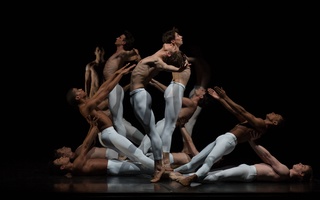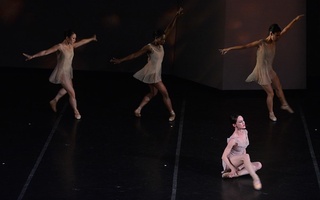The Boston Ballet certainly has a remarkable, and well-deserved, reputation. For years, the company has thrilled and delighted audiences with a deft mixture of classic ballet and innovative new dance productions. "The Nutcracker," for instance, remains a perennial classic, holiday season after holiday season. And just last year the snazzy, jazzy world premiere of "Hot and Cool" won over audiences and critics alike.
Unfortunately, even world-renowned traditions must occasionally be broken. With the new collaboration of three entirely different ballets, collectively called "Boogie, Brass, and Blue," the Boston Ballet has proved that sometimes even the best of ideas do not work out quite as well as originally planned. After one views the three pieces in their entirety, it becomes difficult to see what exactly connects them all together, other than the fact that they're all contemporary ballets.
The first dance, entitled "Company B," is basically a lighthearted demonstration of fun 1940's-style dances, against the darker overtones of the tragedies of World War II. Some dancers, particularly Pollyana Ribeiro in "Rum and Coca-Cola" and Paul Thrussell in "Oh Johnny," win lauds for balancing spirited charm with grace and elegance. Unfortunately, many of the other performers do not seem to know now to have fun. In the supposedly-lively "Pennsylvania Polka," dancers Jennifer Gelfand and Carlos Ivan Santos look uncomfortable and embarrassed to be doing the polka between melodramatic air-kisses on-stage.
"VII For VIII," the second ballet performed, opens on a note eons away from the innocent romanticism of "Company B." Choreographer Elisa Monte describes her dance, set to bass-pounding, Eurotechno "music," as "a personal duet dealing with couples in a love-oriented environment," in which the "moods of a relationship...ecstasy, anger" were emphatically expressed.
And expressed they are. With four sets of couples swirling and writhing in neon-colored Spandex bodysuits to thoroughly unconventional ballet music, excessive subtlety is never a problem. The blatant eroticism sparkling on stage may make the more conservative ballet-goers shift uncomfortably in their seats, but the strength and expressiveness of the dancers is unarguably remarkable. Some of the more enjoyable pieces are the ones that explore the differences between the friendships of men and those of women. Yet one of the most glorious dances in the entire ballet has to be the final number, in which the couples simultaneously perform the exact same duet-yet none of them even notice one another. They dance this dance of love together, yet entirely alone.
The final, and perhaps most perplexing, of all the ballets is a world premiere entitled "passage." Set to Enigma-style music, some of which was written by Hildergard von Bingen in the eleventh century, this dance does not seem to know what exactly it wants to be. The simple, elegant costumes, paired with sublime yet fantastic lighting, create a mood of long ago-something between the chivalry of the Middle Ages, and the mystery of ancient Egypt. The dance corps does demonstrate a timeless-though somewhat flavorless-elegance, but the reed-like poles they use quickly degenerate from quirky and innovative into annoyingly phallic.
However, the gracefully poised and remarkably strong Adriana Suarez is absolutely phenomenal in her soloist role. She is a picture of both the classic delicateness associated with female beauty, and the commanding presence of a powerful and resilient woman. Despite the confusion of genres all around her, she is still breathtaking to watch.
Although all of the ballets in "Boogie, Brass, and Blue" are fine performances in and of themselves, it is difficult to say what exactly ties them all together. Self-dubbed "A Celebration of All-American Dance," the show is not decidedly un-Amercan, but it can hardly be called patriotic. Perhaps under a different title and theme, the performance could flow much better and more appropriately. But for now, perhaps audiences should ignore the false advertising, and simply attend "Boogie, Brass and Blue" not to see one enthusiastic show, but rather three excellent-though entirely unrelated-forms of ballet.
Read more in Arts
Jim Carey Should Be UnpluggedRecommended Articles
-
Legends of DanceLEGENDS OF DANCE At the Boston Conservatory Dance Theater October 30th Legends of Dance, presented by the Boston Conservatory Dance
-
Male Dancers Prominently Featured in BalletBoston Ballet's Fall Program highlights its male talent.
-
 Boston Ballet’s 'Third Symphony' Pushes Boundaries
Boston Ballet’s 'Third Symphony' Pushes Boundaries -
 José Mateo Ballet’s “Assault on the Senses” Blends Vigor With Grace
José Mateo Ballet’s “Assault on the Senses” Blends Vigor With Grace -
 Les Ballets Jazz Montréal Loses Sight of Its Powerful Purpose
Les Ballets Jazz Montréal Loses Sight of Its Powerful Purpose













